Handling and Cooking Game
Circular 495
Mae Martha Johnson, Extension Food and Nutrition Specialist
James Knight, Extension Wildlife Specialist
College of Agriculture, Consumer and Environmental Sciences New Mexico State University
Each year hunters waste thousands of pounds of m eat through carelessness, ignorance, or neglect. Here are some suggestions to help you preserve your meat so that you can deliver it in good condition to the cook or to the freezer. The quality and flavor of the meat depends a great deal on the care you give it from the moment it is killed.
The expert hunter cares for game immediately. Strong flavor is due to:
- Inadequate bleeding
- Carelessness or delay in dressing
- Failure to cool the carcass promptly and thoroughly
- Wounds causing the blood to spread along membranes
The first hour an animal is shot is the most critical period. Skin, clean, and hang the carcass to cool immediately.
Bleeding
There are various op in ions on bleeding animals. When animals have been shot in the thorax, internal bleeding into the lung cavity may be enough. Neck or head shots take additional bleeding. Some hunters open the carcass and sever the large blood vessel leading to the heart (point B, fig. 1). If no trophy is desired, slashing the throat will aid bleeding (point A, fig. 1).

Figure 1.
There are probably as many techniques for dressing the kill as there are hunters and kinds of animals. A carefully dressed animal is the hunter’s pride.
Since time is vital to the quality of the meat, start by removing the entrails quickly and completely to begin the cooling process immediately.
To dress, lay the animal so the head is slightly up hill. Insert the blade of a sharp knife beneath the hide and the belly muscle directly below the breastbone. Cut along the center line towards the tail (fig. 2). Keep the blade of the knife pointed upward, being careful not to puncture or rupture the intestines. Stop about five to six inches from the tail. Cut a circle as shown in fig. 2. Musk glands at A and B may be removed. These glands cease to function at death, but surface residue may taint the meat it touches.
Cut the bone and skin from the first rib to the throat. Turning the carcass down hill, split the pelvic bone between the back legs with a small hatchet.
Split open the neck, cutting through the breastbone, and expose the windpipe.

Figure 2.
Turn the carcass uphill and clip the gullet. Then the entire visceral mass can be removed without severing any part. Clean the heart and liver to prepare on the hunt or to take home. Cut away bloodshot and badly bruised areas to prevent extensive spoilage. Wipe the body cavity thoroughly with a clean cloth, or wash and wipe dry. Prop the cavity open with sharpened sticks and hang the carcass in a tree until the cavity surface is thoroughly dry. Be sure there is good air circulation.
Some hunters prefer to skin the animal while dressing it. After skinning, wrap the carcass in light muslin, cheesecloth, or mosquito netting to cool. This covering will keep flies, bugs, and dust from the meat. For ease in handling, quarter the carcass and hang the quarters in light muslin bags for cooling. Avoid heavy tarpaulins or canvas bags that hold in the heat.
Other hunters like to leave the hide on for protection on the homeward trip. Insofar as possible, keep the animal cool when transporting it. Carrying it on the hood of the automobile may cause heating thus spoiling the meat quality. A six-hour cooling period is recommended by many hunters before transporting.
By day, especially warm days, you may have to hang your kill inside an open tent to keep it in the shade. At night, hang it out of doors where it is cooler. Meat sours rapidly when warm and moist. Bear, javelina and other animals with a high percentage of fat will spoil quickly if not cooled. At temperatures above 40° F these animals must be refrigerated within 12 hours.
Skinning
When skinning an animal, roil the hide away from the cavity and under to give a grip that will help in skinning and that will prevent injury to the hide. Deer, elk and antelope hides make fine gloves, jackets, and jacket linings. Antelope skin doesn’t wear as well as deer or elk. If you plan to use the hide, avoid damaging it by dragging or careless handling. Salt the hides with non iodized salt (two to three pounds for the average deer hide) immediately after removing to prevent spoilage. Iodized salt will discolor the hide.
Aging and Freezing
While it is considered wise to age game meat, there is little agreement on the length of time. In general, about ten days at 35 degrees to 40 degrees F will be satisfactory. Aging allows the meat to firm and gives the body enzymes time to tenderize the muscle. Frozen meat does not age.
For best flavor, six to eight months is considered maximum keeping time of frozen game. Many authorities advise allowing less time.
Cutting
When cutting the meat, trim off any remaining fat. The fat from wild game is responsible for much of the wild taste and tends to become rancid quickly.
A butcher will do a good job of cutting and wrapping for freezer or for further use. It is important to tell him what cuts you want, the number in the family, and how the cut will probably be served.
If you cut it yourself, be sure you have a clean, roomy, well ventilated place to work as well as sharp knives, saw, and other equipment. Trim off all discolored or bloody parts and fat as you come to them. The main cuts are similar to those of a beef carcass and may be cut into steaks and roasts or ground for burger.
Game Birds
Most general recommendations for handling game animals also apply to handling game birds.
Many hunters prefer to draw game birds in the field since it is best to dress and cool them as soon as possible. Wipe out the cavity with dean paper or cloth and hang or lay the bird in a well ventilated place to cool. Hanging close together or stacking game birds in a mass may cause heating.
Pluck birds while they are dry and still warm, or skin them. If plucked, singe them over a flame to remove the down except for water fowl.
Paraffin and water removes the down and small feathers from plucked ducks or geese. For six medium birds, use three cakes of paraffin and six quarts of hot water in a deep (but not wide) kettle. Bring to a boil. Dip the fowl one at a time so that a thin coat of wax covers all feathers. Cool them until the wax hardens. Scrape away the feathers and wax with a knife.
If a game bird (except waterfowl) can be lifted by the lower bill without its breaking, it is a mature bird and is considered less tender. The outer end of the breastbone is rather flexible in any young bird. Knowing the age of a bird will dictate how it should be cooked.
Aging game birds 24 to 48 hours just above freezing temperature removes much of the wild flavor.
Filleting Fish
Make the first cut just behind the gills. Slice down to the bone; then, without removing the blade, turn it and slice straight along backbone to the tail. Note that the fillet has been cut away from the rest of the fish. After slicing fillet off at tail, turn fish over and repeat procedure on the other side.
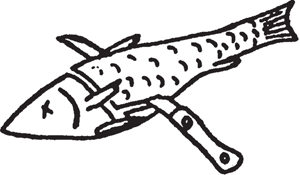

With both sides removed, you have cut away both fillets without disturbing fish’s entrails. This is the neatest and fastest way to prepare fish. Now to finish the fillets.
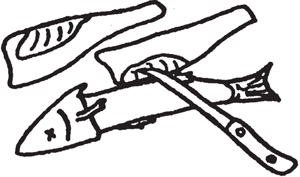
Next step is to remove the rib section. A sharp, flexible knife is important to avoid wasting meat. Insert blade close to rib bones and slice entire section away.
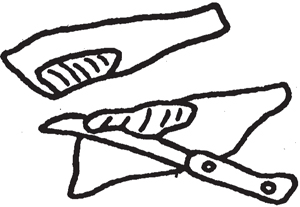
Insert knife at tail and cut meat from the skin.

Now each fillet is ready for the pan or freezer. Note there is no waste. Remember not to overwash the fillets. This will preserve tasty juices and keep meat in its firm natural state.

Dressing Rattlesnake
Cut off head and rattles. Slit along belly.

Draw (remove viscera)
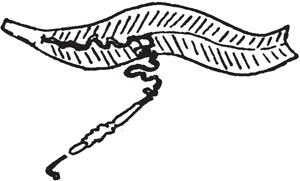
Skin.
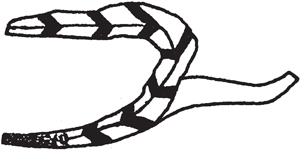
Cut in chunks about two inches long.

Cooking Game
It is not necessary to have specific recipes for cooking wild game. Use the following table to determine which domestic animal your game animal is most like. Then use your favorite recipe, or refer to the chart to determine the best method of cooking.
| Chicken | Duck Goose |
Beef | Pork | Fish |
| Crow | Duck | Beaver | Bear | Fish |
| Dove | Goose | Deer (Venison) | Groundhog | |
| Frog Legs | Coot | Elk | (Woodchuck) | |
| Grouse | Pronghorn | Muskrat | ||
| Rattlesnake | Oryx | Opossum | ||
| Quail | Ibex | Rabbit | ||
| Turtle | Barbary Sheep | Raccoon | ||
| Wilson’s Snipe | Squirrel | |||
| Woodcock | Armadillo | |||
| Turkey | Javelina | |||
| Pheasant | ||||
| Chukar |
Table 1: Cooking Methods for Game.
| Game | Braise | Fry | Roast | BBQ | Broil | Smoke | Stew | Bake |
| Bear | X | X | X | X | ||||
| Beaver | X | X | X | X | X | X | ||
| Coot | X | X | ||||||
| Crow | X | |||||||
| Deer (Venison) | X | X | X | X | X | X | X | |
| Dove | X* | X | X | X | ||||
| Duck | X* | X | X | |||||
| Frog Legs | X* | X | ||||||
| Goose | X* | X | ||||||
| Groundhog (Woodchuck) | X | X | X* | X | X | |||
| Grouse | X | X | X | X | ||||
| Muscrat | X* | X | X | X | X | X | ||
| Opossum | X* | X | X | |||||
| Quail | X* | X | X | X | X | X | ||
| Rabbit | X | X | X | X* | X | X | X | |
| Raccoon | X | X | X | |||||
| Rattlesnake | X | X | ||||||
| Squirrel | X* | X | X | X | X | |||
| Turkey | X | X* | X | X | ||||
| Turtle | X | X | X | |||||
| Wild Hog | X | X* | X | |||||
| Wilson’s Snipe | X | X | X | X | ||||
| Woodcock | X | X | X | X | ||||
| *Preferred method for preparing specific game. | ||||||||
Venison Mincemeat
| 2 lb cooked venison, chopped | 4 lb chopped apples |
| 4 cup either brown or white sugar | 2 lb raisins |
| 4 cup apple cider | 3/4 lb chopped suet or butter |
| 1/2 tsp cloves | 1 tsp mace |
| 1/2 tsp nutmeg | 2 tsp salt |
| 1 1/2 tsp cinnamon |
Combine ingredients. Cook very slowly for 1 hour, stirring frequently to prevent sticking.
Pack hot into hot jars, leaving 1 inch head space. Adjust caps. Process pints or quarts for 30 minutes at 15 pounds pressure in a steam pressure canner.
Jerky
| 5 lb game meat | 3/4 cup non iodized salt |
| 3/4 cup sugar | 1 tsp garlic juice or powder |
| 1 tsp Tabasco sauce | 1/2 gallon water |
Cut meat into thin strips; remove fat and tendinous tissue. Make a brine of salt, sugar, garlic juice, Tabasco sauce, and water. Soak meat in brine for 8 hours. Rinse slightly in fresh water and place meat on a rack so the pieces do not overlap. Allow to air dry for 1–2 hours or until a slight glaze appears on the meat. If using an oven, put racks of meat into pans and set in a 150° F oven for 11 hours. If using a smoker place on rack and smoke to desired degree of dryness, 12–24 hours.
Game Ideas
- Try game meats in any of your favorite recipes that are spicy.
- Game meats make excellent chile con carne.
- Game meat may be ground in a food grinder or chopped in a food processor. If a grind or food processor is not available, cube the meat and cook in a stew.
- To tenderize, or to enhance game flavor: Cover meat with one of the following marinades and allow to stand in the refrigerator at least 24 hours. Broil or roast.
| Vinegar (to cover steak or roast) |
| French dressing |
| Tomato sauce or undiluted tomato soup |
| Tomato juice |
| Fruit juice (such as lemon, pineapple, or a mixture of many juices) |
| 1/4 cup vinegar, 1.2 cup cooking oil, 1/2 teaspoon pepper and 1/4 teaspoon garlic salt |
| 2 cups water, 2 cups vinegar, 1 to 2 tablespoons sugar, 4 bay leaves, 1 teaspoon salt, 12 whole cloves, 1 teaspoon allspice, 3 medium onions, sliced. |
| Garlic salt, salt and pepper to taste, and equal parts of Worcestershire sauce and two of your favorite steak sauces. This gives a blend of flavors and also is excellent for basting game roasts or thick steaks during cooking. |
To find more resources for your business, home, or family, visit the College of Agricultural, Consumer and Environmental Sciences on the World Wide Web at pubs.nmsu.edu.
Contents of publications may be freely reproduced for educational purposes. All other rights reserved. For permission to use publications for other purposes, contact pubs@nmsu.edu or the authors listed on the publication.
New Mexico State University is an equal opportunity/affirmative action employer and educator. NMSU and the U.S. Department of Agriculture cooperating.
February 1997, Las Cruces, NM


